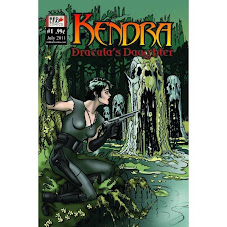 Well here we are folks, the final E-Dispatches from the Great White North for 2008.
Well here we are folks, the final E-Dispatches from the Great White North for 2008.As some of you know I send this column off from the Port Stanley Public Library and each year from December 23, 2008 to January 2, 2009 the library is closed. In some ways that's great for me as it gives me a chance to hide out at my home/office and develop some new projects to work on in 2009 but part of me always misses the daily insanity of hanging out here at the library.
Anyway, with this being the final installment for the year I thought I would take a moment and talk about what my plans are for this column of 2009. I will of course be continuing with the historical overview of the MLJ Magazines/Archie Comic Publications superhero lines and if all goes according to plan I should have it all wrapped up by the end of February at the latest. To be honest I hadn't planned on it running this long but one thing lead to another and, well, here we are.
 Once that's all done my next endeavour will be a two to three part historical overview of Blue Moon Comics Group. For those of you who have never heard of Blue Moon Comics Group all I'll tell you right now about it is that it was a small press comics publisher that whose publisher was none other than my best buddy, The Groovy Agent which published comics works by a number of talented people including Dick Ayers, Seppo Makinen, Steve Skeates and Ed Quinby just to name a few. I also did a thing or two for Blue Moon over the years. Some of the series I did that saw print under the Blue Moon slug included Mister Chameleon, Solomon Wyrd and The Aquanauts to name a few. Some series that I developed initially for Blue Moon but ended up being published elsewhere include The Young Immortals, The Hooded Cobra and Captain Sentinel and the Lads of Liberty. Anyway, the full story about Blue Moon Comics Group will be revealed around March of next year so watch for that one.
Once that's all done my next endeavour will be a two to three part historical overview of Blue Moon Comics Group. For those of you who have never heard of Blue Moon Comics Group all I'll tell you right now about it is that it was a small press comics publisher that whose publisher was none other than my best buddy, The Groovy Agent which published comics works by a number of talented people including Dick Ayers, Seppo Makinen, Steve Skeates and Ed Quinby just to name a few. I also did a thing or two for Blue Moon over the years. Some of the series I did that saw print under the Blue Moon slug included Mister Chameleon, Solomon Wyrd and The Aquanauts to name a few. Some series that I developed initially for Blue Moon but ended up being published elsewhere include The Young Immortals, The Hooded Cobra and Captain Sentinel and the Lads of Liberty. Anyway, the full story about Blue Moon Comics Group will be revealed around March of next year so watch for that one.While your at it be sure to keep your eyes on http://dispatchesfromthegreatwhitenorth.blogspot.com as beginning in January 2009 I will be doing E-Dispatches that are exclusive to that site. This column will continue to appear of course at www.jazmaonline.com/edispatch , in the electronic version of The People's Comic Book Newsletter and at the Fun_Features yahoo group (where you can also by the way find every installment of the newspaper column I used to write called "Did you know about...?") but from time to time I'll be doing a piece which will appear only at the blog. I haven't as yet come up with a title-and am currently using the E-Dispatches Xtra working title-so if anyone out there has a title suggestion I'd love to hear it.
 As for what I'll be writing about in "E-Dispatches Xtra"; so far I am planning to do some spotlight pieces on some of the MLJ/Archie heroes including The Shield, The Comet and the legendary Pow Girl plus some commentaries on comics and the comics industry, past and present. So be sure to keep your eyes open for the new addition to http://dispatchesfromthegreatwhitenoth.blogspot.com site in 2009 . The first installment will hopefully be appearing in the third week of January.
As for what I'll be writing about in "E-Dispatches Xtra"; so far I am planning to do some spotlight pieces on some of the MLJ/Archie heroes including The Shield, The Comet and the legendary Pow Girl plus some commentaries on comics and the comics industry, past and present. So be sure to keep your eyes open for the new addition to http://dispatchesfromthegreatwhitenoth.blogspot.com site in 2009 . The first installment will hopefully be appearing in the third week of January.So those are pretty much the plans for E-Dispatches in 2009. As for what else I am working on over the Holidays I'll fill everyone in come late January or early February once I've finalized a few plans. In the mean time, while you are waiting for me to come back why not take a look at The Groovy Agent's excellent column about comics of the 1970s. It's titled Diversions of The Groovy Kind and can be found at http://diversionsofthegroovykind.blogspot.com . Tell him Jazzy Jon sent ya.
That's it folks! Have an enjoyable Holiday Season and I'll "see" everyone in 2009.



















































